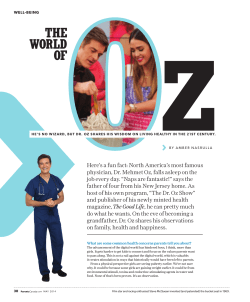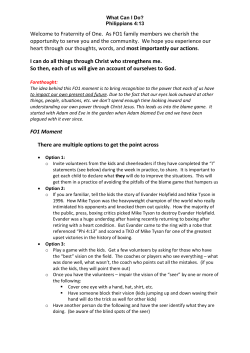
Child-Directed Marketing Within and Around Fast-Food Restaurants Research Brief December 2012
Research Brief December 2012 Child-Directed Marketing Within and Around Fast-Food Restaurants This brief provides an overview of child-directed marketing within and around fast-food restaurants and examines how these marketing practices vary by neighborhood income and race and ethnicity. Using validated instruments, trained staff gathered data from 2,176 fast-food restaurants located in a nationally representative sample of public middle- and high-school enrollment areas in 2010. For these analyses, child-directed marketing was defined as the presence of one or more of the following: exterior advertisements with cartoon characters; exterior advertisements with movie, television, or sports figures; exterior advertisements for kids’ meal toys; 3-D cartoon characters on the exterior; exterior play area; interior play area; in-store displays of kids’ meal toys; and other child-directed marketing, such as advertisements for children’s birthday parties. Introduction Consumption of fast food has increased over the past few decades and is associated with poor health outcomes, including increased risk of obesity.1 Fast food is the secondlargest source of calories among youths ages 2 to 18, accounting for 13 percent of their total caloric intake.2 Many children eat fast food often: in 2007–08, 33 percent of 2- to 11-year-olds and 41 percent of 12- to 19-year-olds consumed food or beverages from a fast-food restaurant on a given day.3 Children who eat fast food have a higher intake of calories, total fat, saturated fat, sodium, sugar, and sugarsweetened beverages than those who do not eat fast food.4 Children who eat fast food also are less likely to meet dietary recommendations for fruits, vegetables, and dairy.5 The fast-food industry spends $660 million to market its products to children and adolescents each year and spends the most on toys for kids’ meals—$360 million for the cost of toys alone.6 These efforts help fast-food restaurants sell more than 1.2 billion kids’ meals annually, and those sales account for 20 percent of all foods and beverages sold for consumption by children.6 This has serious health implications. Research overwhelmingly shows that the vast majority of fast-food kids’ meals do not align with national dietary recommendations7,8 and that early exposure to marketing practices instills brand recognition and shapes future consumption patterns.9,10 BTG Research Brief – Child-Directed Marketing Within and Around Fast-Food Restaurants | www.bridgingthegapresearch.org 1 In response to concerns about excessive marketing of of child-directed marketing is for high-calorie, nutrient- unhealthy products to youths,11 16 major food and beverage poor foods;7,13,14 that fast-food companies have increased companies are members of the Children’s Food and Beverage child-directed marketing;14,15 and that fast-food companies Advertising Initiative (CFBAI), which was launched in target young people living in lower-income communities and 2006. Companies that participate in this voluntary initiative communities of color.16–18 However, child-directed marketing agree to limit child-directed marketing to healthier foods and practices within and around fast-food restaurants have not beverages. Only two fast-food companies, McDonald’s and been examined. 12 Burger King, are part of the CFBAI. These two companies pledged to advertise only products that meet company- Given the prevalence of fast-food consumption among youths established nutrition criteria to children under age 12 and and the serious health implications, evaluating child-directed began implementing their CFBAI pledges in 2007. Both marketing is critical. This brief summarizes the extent and McDonald’s and Burger King recently updated their pledges scope of child-directed marketing within and around fast- to include new uniform nutrition criteria, which were food restaurants that are located in communities surrounding developed by CFBAI for participating companies. public middle and high schools. It also assesses how these 12 marketing practices vary by neighborhood income and race and ethnicity. Despite efforts by the food and beverage industry to selfregulate, independent research shows that the vast majority Figure 1 Prevalence of Child-Directed Marketing Within and Around Fast-Food Restaurants by Neighborhood Characteristics All Neighborhoods By Neighborhood Race/Ethnicity By Neighborhood Income % of prevalence 35 30 31 30 25 20 22 24 24 24 18 15 21 22 18 10 5 0 All White Neighborhoods Black Latino Diverse Low Near-low Middle Near-high High The following comparisons are statistically significant at p≤0.05: majority Black vs. diverse and high-income vs. middle-income. BTG Research Brief – Child-Directed Marketing Within and Around Fast-Food Restaurants | www.bridgingthegapresearch.org 2 Key Findings More than one-fifth (22%) of all fast-food restaurants use child-directed marketing within and around the building to promote their offerings to children. These practices are most prevalent in majority Black neighborhoods and middleincome neighborhoods (Figure 1). • Fast-food restaurants are significantly more likely to use child-directed marketing in majority Black neighborhoods (31%) than in racially diverse neighborhoods (18%). • Child-directed marketing is significantly more prevalent among fast-food restaurants in middle-income neighborhoods (30%) compared with those in the highest income neighborhoods (18%). • Irrespective of their chain status, fast-food restaurants that offer kids’ meals use child-directed marketing strategies much more often compared with those that do not offer kids’ meals. The most prevalent child-directed marketing strategy used by fast-food restaurants is an indoor display for kids’ meals toys (Figure 2). • Twenty-five percent of all fast-food restaurants that offer kids’ meals have an indoor display for kids’ meals toys. • Chain restaurants offering kids’ meals are more likely to display kids’ meals toys inside the restaurant (31%) than Compared with all fast-food restaurants, those that offer kids’ meals use child-directed marketing strategies more often than those that do not offer kids’ meals (Table 1). • Chain fast-food restaurants (75%), including CFBAI non-chain restaurants that offer kids’ meals (9%). • The prevalence is even higher among the two CFBAI fastfood chains—67 percent of McDonald’s and Burger King’s restaurants display kids’ meals toys inside. These chains members, are significantly more likely to offer kids’ meals also have higher prevalence of all types of child-directed than non-chain restaurants (34%). Both chains that marketing strategies within and around restaurants than participate in CFBAI—McDonald’s and Burger King— any other fast-food restaurant that offers kids’ meals. offer kids’ meals. TA B L E 1 Percentage of Fast-Food Restaurants that Offer Kids’ Meals and Use Child-Directed Marketing Within and Around their Buildings Use of Child-Directed Marketing Within and Around Fast-Food Restaurants Chain Status Fast-Food Restaurants Offering Kids’ Meals Offering Kids’ Meals Not Offering Kids’ Meals All Fast-Food Restaurants 56% 38% 2% Non-Chain Restaurants 34% 13% 1% Chain Restaurants 75% 47% 5% CFBAI Participating Chain Restaurants 100% 91% ^ ^ McDonald’s and Burger King are the only two fast-food chains that participate in the CFBAI and all of their restaurants offer kids’ meals. BTG Research Brief – Child-Directed Marketing Within and Around Fast-Food Restaurants | www.bridgingthegapresearch.org 3 Figure 2 Prevalence of Various Child-Directed Marketing Strategies Used Within and Around Fast-Food Restaurants that Serve Kids’ Meals, By Chain Status Indoor display of kids’ meal toys 3-D cartoon characters on exterior Exterior ads with cartoon characters Exterior play area Exterior ads with TV/movie/sport figures Interior play area Exterior ads with kids’ meal toys Other child-directed ads on exterior % of prevalence 67 70 60 50 43 40 30 20 10 35 34 31 25 27 15 8 7 11 9 7 1 2 12 11 10 9 1 0 1 0 0 1 2 19 15 1 2 4 8 0 All Fast-Food Restaurants Non-Chain Restaurants Chain Restaurants CFBAI Participating Chain Restaurants 18 Conclusions and Policy Implications both restaurant chains are meeting their CFBAI pledges. Child-directed marketing within and around fast-food such as launching a menu labeling initiative before a pending restaurants, especially those located in majority Black federal rule that will require large restaurant chains to post communities, which are disproportionately affected by calorie information on their menus and menu boards. McDonald’s also has provided leadership in other instances, obesity, is a serious concern. The poor nutritional quality of kids’ meals and the very limited selection of healthy options Given that fast-food restaurants sell 1.2 billion kids’ meals in such meals is well-documented.4,5,7 A report from the each year and their child-directed marketing focuses heavily Rudd Center rated kids’ meals offered by McDonald’s and on toys that accompany these meals, advocacy efforts to Burger King, which are the only two fast-food companies change such marketing practices could have a significant that participate in the CFBAI, as worse than meals from impact on children’s diets and health. For example, advocates other fast-food restaurants in terms of meeting established have proposed that state and local governments take nutritional criteria. action, including setting nutrition standards for meals that 7 accompany toys. 20-22 Efforts to limit the distribution of kids’ Every McDonald’s and Burger King restaurant in this analysis meals toys in conjunction with foods and beverages that do offered kids’ meals, and more than 90 percent engaged in not meet nutritional criteria have proved feasible.23 However, child-directed marketing within and outside of their buildings. the restaurant and advertising industries strongly oppose However, according to a report published by CFBAI, such efforts.24,25 19 BTG Research Brief – Child-Directed Marketing Within and Around Fast-Food Restaurants | www.bridgingthegapresearch.org 4 The Institute of Medicine report Accelerating Progress in This study is based on data from 2,176 fast-food restaurants Obesity Prevention reiterates the urgent need for the food, located in a nationally representative sample of public middle beverage, restaurant, and media industries to market only and high school enrollment areas. Data were collected during those foods that support a diet aligned with the Dietary the spring and summer of 2010 from 154 communities Guidelines for Americans to children and adolescents ages across the United States. Results are presented separately 2 to 17. Comprehensive and consistent nutritional guidelines for all fast-food restaurants and for those that offer kids’ are needed to ensure that only healthy foods are marketed to meals. Fast-food restaurants are categorized into chain and youths. Those proposed by the Interagency Working Group non-chain restaurants (based on Restaurants & Institutions on Food Marketed to Children, which would limit children’s magazine’s listing),28 and those that are part of the CFBAI. exposure to products high in unhealthy fats, added sugars, For this study, communities around schools were classified and sodium and also would encourage food groups that make into four mutually exclusive and exhaustive subgroups a meaningful contribution to a healthy diet, could serve as a according to the proportion of White, Black, and Latino model for stronger guidelines. population. Each community was classified as one of the 26 27 following: majority White (≥66% White residents), majority In 2012, both Burger King and McDonald’s updated their Black (≥50% Black residents), majority Latino (≥50% Latino CFBAI pledges to follow new uniform nutrition criteria, residents), or diverse (no clear majority of White, Black, but the criteria are weaker than those proposed by the or Latino residents). Communities also were classified by Interagency Work Group. Burger King agreed to expand its income quintiles into five categories: low income, near-low pledge to some in-restaurant promotions, but McDonald’s income, middle income, near-high income, and high income. restated pledge does not include in-restaurant promotion strategies.8 Encouraging more fast-food restaurants to join the CFBAI, strengthening CFBAI’s uniform nutrition criteria, and expanding the current CFBAI agreements to consistently include child-directed marketing within and around fast-food restaurants, as well as at point of sale, also would help to limit children’s exposure to unhealthy food advertising. Study Overview The findings in this brief are based on data from the Bridging the Gap Community Obesity Measures Project (BTG-COMP), an ongoing, large-scale effort conducted by the Bridging the Gap research team. BTG-COMP identifies local policy and environmental factors that are likely to be important determinants of healthy eating, physical activity, and obesity among children and adolescents. BTG-COMP collects, analyzes, and shares data about local policies and environmental characteristics relevant to fast-food restaurants, food stores, parks, physical activity facilities, school grounds, and street segments in a nationally representative sample of communities where public school students live. BTG Research Brief – Child-Directed Marketing Within and Around Fast-Food Restaurants | www.bridgingthegapresearch.org 5 Suggested Citation About Bridging the Gap Ohri-Vachaspati P, Powell LM, Rimkus LM, Isgor Z, Barker D and Bridging the Gap is a nationally recognized research program of Chaloupka FJ. Child-Directed Marketing Within and Around Fast- the Robert Wood Johnson Foundation dedicated to improving the Food Restaurants—A BTG Research Brief. Chicago, IL: Bridging the understanding of how policies and environmental factors influence Gap Program, Health Policy Center, Institute for Health Research diet, physical activity and obesity among youth, as well as youth and Policy, University of Illinois at Chicago, 2012. tobacco use. The program identifies and tracks information at the www.bridgingthegapresearch.org state, community and school levels; measures change over time; and shares findings that will help advance effective solutions for reversing the childhood obesity epidemic and preventing young people from smoking. Bridging the Gap is a joint project of the University of Illinois at Chicago’s Institute for Health Research and Policy and the University of Michigan’s Institute for Social Research. For more information, visit www.bridgingthegapresearch.org Endnotes 1. Fulkerson JA, Farbakhsh K, Lytle L, et al. Away-from-home 8. Wu HW, Sturm R. What’s on the menu? A review of the energy and nutritional content of US chain restaurant menus. family dinner sources and associations with weight status, Public Health Nutr. 2012:1–10. body composition, and related biomarkers of chronic disease among adolescents and their parents. J Am Diet Assoc. 2011;111(12):1892–1897. 2. Poti JM, Popkin BM. Trends in energy intake among US children by eating location and food source, 1977-2006. J Am Diet Assoc. 2011;111(8):1156–1164. 3. Powell LM, Nguyen BT. Energy intake from restaurants: 9. Ji MF. Children’s relationships with brands: “True love” or “one-night” stand? Psychol Market. 2002;19(4):369–387. 10. Valkenburg PM, Buijzen M. Identifying determinants of young children’s brand awareness: Television, parents, and peers. App Dev Psychol. 2005;26(4):456–468. 11. Institute of Medicine (IOM). Food marketing to children demographics and socioeconomics, 2003–2008. and youth: Threat or opportunity?–Institute of Medicine. Am J Prev Med. 2012 Nov;43(5):498-504. National Academy of Sciences Available at: http://iom.edu/ 4. Powell LM, Nguyen BT. Fast-food and full-service restaurant consumption among children and adolescents: Effect on energy, beverage, and nutrient intake. Arch Pediatr Adolesc Med. In Press. 5. Sebastian RS, Wilkinson EC, Goldman JD. US Adolescents and MyPyramid: Associations between fast-food consumption and lower likelihood of meeting recommendations. J Am Diet Assoc. 2009;109(2):226–235. 6. Federal Trade Commission (FTC). Marketing food to Reports/2005/Food-Marketing-to-Children-and-Youth-Threator-Opportunity.aspx. Accessed May 23, 2012. 12. Council of Better Business Bureaus. Children’s Food and Beverage Advertising Initiative. Available at: http://www.bbb. org/us/childrens-food-and-beverage-advertising-initiative/. Accessed May 23, 2012. 13. Batada A, Seitz MD, Wootan MG, Story M. Nine out of 10 food advertisements shown during Saturday morning children’s television programming are for foods high in fat, children and adolescents. Available at: http://www.ftc.gov/ sodium, or added sugars, or low in nutrients. J Am Diet Assoc. opa/2008/07/foodmkting.shtm. Accessed May 23, 2012. 2008;108(4):673–678. 7. Harris J, Schwartz M, Brownell K. Fast food facts: Evaluating fast food nutrition and marketing to youth. Yale Rudd Center; 2010. BTG Research Brief – Child-Directed Marketing Within and Around Fast-Food Restaurants | www.bridgingthegapresearch.org 6 14. Powell LM, Schermbeck RM, Szczypka G, Chaloupka FJ, 22. National Policy & Legal Analysis Network. Creating healthier Braunschweig CL. Trends in the nutritional content of television toy giveaway meals. Available at: http://www.nplanonline.org/ food advertisements seen by children in the United States: childhood-obesity/products/model-ord-healthy-toy-giveaway. Analyses by age, food categories, and companies. Arch Pediatr Accessed May 23, 2012. Adolesc Med. 2011;165(12):1078–1086. 15. Kraak VI, Story M, Wartella EA, Ginter J. Industry progress to market a healthful diet to American children and adolescents. Am J Prev Med. 2011;41(3):322–333. 16. Powell LM, Szczypka G, Chaloupka FJ. Trends in exposure to television food advertisements among children and adolescents in the United States. Arch Pediatr Adolesc Med. 2010;164(9):794–802. 17. Grier SA, Kumanyika SK. The context for choice: Health implications of targeted food and beverage marketing to African Americans. Am J Public Health. 2008;98(9):1616–1629. 18. Yancey AK, Cole BL, Brown R, et al. A cross-sectional prevalence study of ethnically targeted and general audience outdoor obesity-related advertising. Milbank Q. 2009;87(1):155–184. 19. Council of Better Business Bureaus. The Children’s Food 23. Otten JJ, Hekler EB, Krukowski RA, et al. Food marketing to children through toys. Am J Prev Med. 2012;42(1):56–60. 24. National Restaurant Association. Toy ban proposal misguided, overreaching. Available at: http://www.restaurant.org/ nra_news_blog/2010/08/toy-ban-proposal-misguidedoverreaching.cfm. Accessed May 23, 2012. 25. QSR Magazine. Kids meal toy ban challenges first amendment rights. Available at: http://www.qsrmagazine.com/executiveinterviews/taking-stand. Accessed May 23, 2012. 26. Institute of Medicine. Accelerating progress in obesity prevention: Solving the weight of the nation. 2012. Available at: http://www.iom.edu/~/media/Files/Report%20Files/2012/ APOP/APOP_insert.pdf. Accessed May 18, 2012. 27. Federal Trade Commission (FTC), Centers for Disease Control and Prevention, Food and Drug Administration, United States & Beverage Advertising Initiative in action—A report on Department of Agriculture. Interagency Working Group on compliance and implementation during 2010 and a five year food marketed to children: Preliminary proposed nutrition retrospective: 2006-2011. 2011. Available at: http://www.bbb. principles to guide industry self-regulatory efforts: Request for org/us/storage/16/documents/cfbai/cfbai-2010-progress- comments. 2011. report.pdf. Accessed May 23, 2012. 20. Dorfman LE, Wootan MG. The nation needs to do more 28. Restaurants & Institutions. R&I 2009 Top 400 restaurant chains. Available at: http://www.rolypoly.com/news/articles/ to address food marketing to children. Am J Prev Med. R&I%202009%20Top%20400%20Restaurant%20Chains.pdf. 2012;42(3):334–335. Accessed May 23, 2012. 21. Harris JL, Graff SK. Protecting children from harmful food marketing: Options for local government to make a difference. Prev Chronic Dis. 2011;8(5). Available at: http://www.cdc. gov.ezproxy1.lib.asu.edu/pcd/issues/2011/sep/10_0272.htm. Accessed May 23, 2012. BTG Research Brief – Child-Directed Marketing Within and Around Fast-Food Restaurants | www.bridgingthegapresearch.org 7
© Copyright 2025










